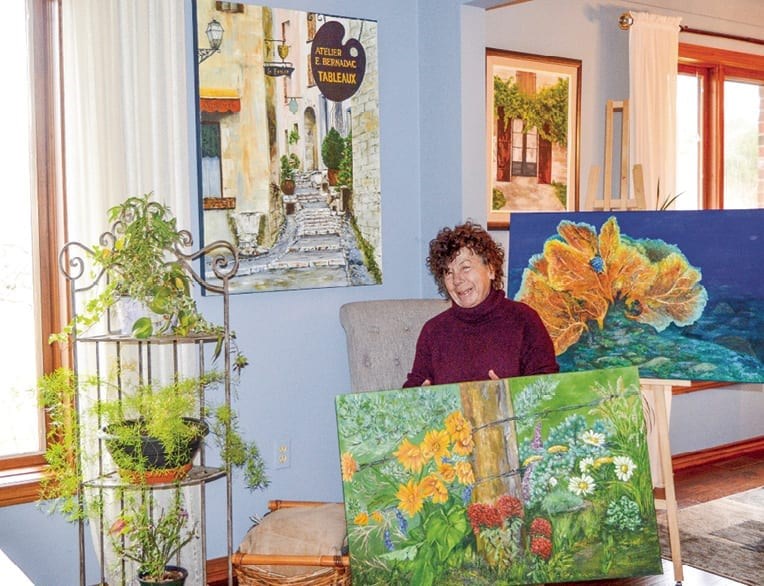BY GLORIA J. KATCH Special to the VOICE
Originating in someone's backyard, the Pelham Art Festival Show and Sale in 33 years has grown from a few painted canvasses and sketches on a lawn to 78 exhibits, luncheons, entertainment, and a wide variety of pleasant activities to fill Mother's Day weekend.
This year's event, from May 10 to 12, is making its community centre premiere, and Heidi TeBrake, the event's committee chair, is ecstatic.
 "It's very exciting. It will be bigger, brighter and fresh," she said, adding that all the additional light in the new building gives the event that "airy feeling." She noted all of these qualities are conducive to a better presentation of the vast variety of artistic pieces, mediums, and jewelry in all its brilliance.
"It's very exciting. It will be bigger, brighter and fresh," she said, adding that all the additional light in the new building gives the event that "airy feeling." She noted all of these qualities are conducive to a better presentation of the vast variety of artistic pieces, mediums, and jewelry in all its brilliance.
This year, the venue will be setup differently and there will be additional booths with about 37 artisans from the Toronto area, eight of whom are brand new. One of TeBrake's goals is to continually offer new artwork, and the Pelham art committee has requested that returning artists showcase different pieces from last year. The event is hailed by many artists because of the genuine enthusiasm the community takes in the art itself, she said. In fact, in the last four or five years, there has been a large "communal maple" tree hanging on a canvas for anyone attending the event to add a few splashes of paint, and collaborate in completing the picture.
Proceeds from the Pelham Art Festival goes toward the Pelham Public Library, as well as provides $1,000 donations and scholarships to E. L. Crossley Secondary School, the Niagara Catholic District School Board, and Niagara College's art design programs. The fundraising event has raised $435,000 for the library over the decades.
Appealing to the curiosity of children, the art show is offering a "scavenger hunt," which requires its participants to seek out and interact with ten artists. The end goal of this game is that children and their parents learn more about various types of art work, pointed out TeBrake. The winner receives an artsy door prize. Anyone interested in this event needs to fill out a form at the show to participate.
The Festival is a juried event, and prizes are awarded based on criteria established by a committee of four "knowledgeable judges,” said TeBrake. For the first time there is a People's Choice award, and one could say Jennifer Emily is a bonafide pro in this category, as she has won several awards from various festivals across Ontario.
She is an artist to the core, and believes art saved her physical and spiritual being. About 10 years ago, Emily had a work-related accident, which caused a head and neck injury so severe that she couldn't hold her head up to draw or sketch at a drafting table. So her husband purchased a floor easel, which allowed her to paint again. While it was painstaking at first, Emily eventually reached a point where she could complete an entire painting. She firmly believes her love of painting helped her get her life back.
"Absolutely, it helped me rehabilitate. I was mourning over losing my art for all those years," she said.
Compelled to "recreate herself," after ten years, Emily has noticed a difference in her painting style following the accident, but she is completely content with the change. "I'm so happy now, and use more different mediums than I used to. It's beautiful," she said.
Emily uses more of an impasto technique now, which incorporates thickening agents, as well as glazes, to enhance the translucent effect. To summarize her signature style, her work is about magnifying objects, flora, fauna and scenery so the details are boldly and beautifully apparent. She enjoys "enlarging everything," lights and shadows sharpen colours, angles and define any characteristics. Emily, who grew up in Pelham, recalls spending a great deal of time walking through gardens, orchards and grape vineyards, and its natural wonder has always touched her aesthetic core.
"I think more about how I grew up and the farmers now." She recalled as a child many fields inundated with vines heavily laden with grapes and berries that were sold to Welch’s for jellies, jams and juice.
Emily captures details in her paintings that go unnoticed by most people, who haven't learned to stop and smell the roses. In fact, her mother and other family and friends will bring her bouquets of flowers to paint, or notify her when their flowers are in bloom. These closeup renderings of scenescapes have previously garnered her awards in juried shows, and especially People's Choice awards.
While she sometimes starts painting from a photograph, she stated the photograph is hers. Emily doesn't believe anyone should replicate a painting of someone else's photo, because of the copyright infringement, although she admits there are artists, and particularly novice artists, who do so.
"It is a way to learn," she admits.
Due to the success of his first art show in Pelham last year, Richard Sereda is returning to participate in this year's event. As a sculptor, he sold about 12 pieces of art, and said the problem now with art shows is constructing enough statues and designs to enter.
Sereda was bitten by the artistic bug in Mexico about 14 years ago when he lived in San Miguela, which he describes as a "fabulous town," with a "great artistic community." He became immersed in the culture and the stylings of sculpting, which involved wood, clay, metal, glass, and a myriad of processes. While this was great for his creativity and for learning how to work with different substances and textures, those materials are not all readily available in the Niagara region.
While he incorporates some styles, Sereda said it is easier to add a polyurethane ingredient to cement, which allows it to be more malleable. He uses it in molds to develop different and detailed figurines, especially for indoor sculptures and outdoor patio pieces that have to be moved. Unfortunately, some of his larger sculptures are too difficult to transport to art shows, he said.
Sculpting requires a person to be both tactile and visual—"You have to feel the pieces," emphasized Sereda.
Working with cement requires dexterity, and it's not all about just working with a spinning wheel, or a hammer and chisel like it's portrayed in the movies, he said. While several of these tools are definitely required for a hard substance like granite, he prefers to work with cement and clays. The advantages of cement is that it's available no matter where an artist is situated, and a mould cast can be sanded and ground after it’s popped out eight hours later.
Sereda also adds paints to cement for colour. However, he admits the water, sanding and dust involved in sculpting is messy, and requires a spacious area. He doesn't have a studio to store all the materials and finished products, and has to be content with working in his garage.
Unlike painting, it is difficult to try and construct a three-dimensional object from a one-dimensional picture.
"They never come out looking like the picture, where it becomes a living, moving piece," he said.
Lately, with the cold weather, Sereda has avoided his garage, and just works sporadically. Unlike Jennifer Emily, he only constructs objects when his imagination strikes him, or his wife makes suggestions.
"I have to be in the right mood to sculpt. I use the analogy of cooking: If you're not into it, it's doesn't taste the same.”
On average, a sculpture takes about a week to do, but Sereda admits there are times when no matter how many attempts and extra blobs of cement he adds, "there are some pieces that never come together." However, his wife and "muse" happily reminds, him to, "sell it or smash it," he said, chuckling.
Sculpting for "commercial purposes" is different than just being creatively self-indulgent. Despite the hard work of keeping up with the demand, Sereda said he enjoys art shows, because they validate his work. He is appreciative when others likes his creations. While the first show was somewhat daunting, he admits being "way past that point now."
Sereda is looking forward to the new location of the Pelham Art Show, because it's more central and "better for traffic.” Some 2,000 people attended the festival last year, and more are expected at the new location.



